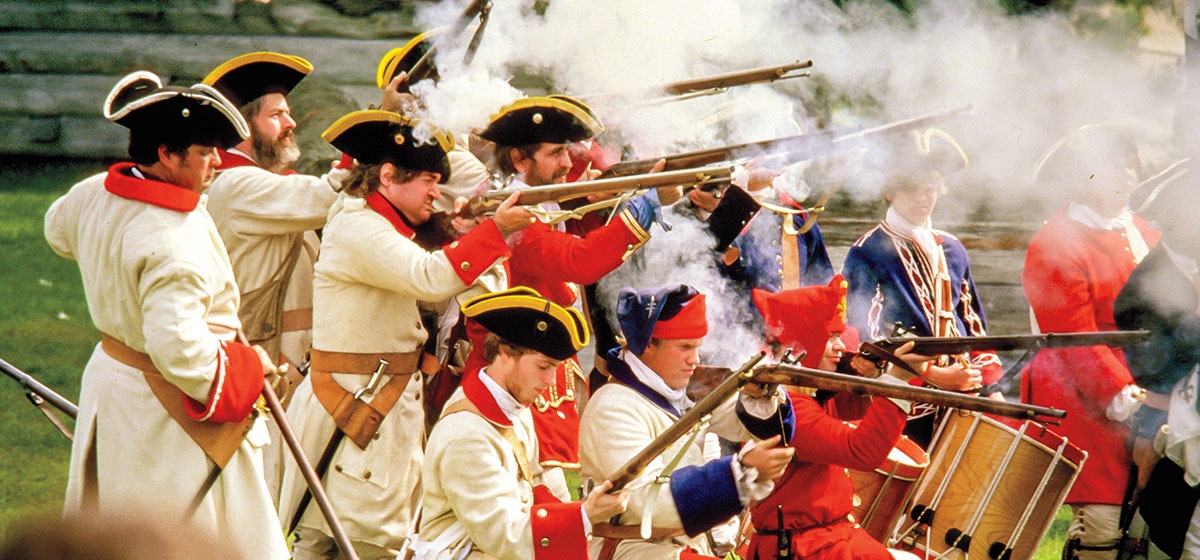
Forbes. Grant. Braddock. Duquesne. Washington. While these read like a list of Pittsburgh streets, they have immense significance to both Pittsburgh and its place in American and world history. But that history began around 50 miles away in Westmoreland County, in what is now the borough of Ligonier.
It’s been kept alive and can be seen today in Fort Ligonier, a reconstruction of the fort built in 1758 by the British to aid in their campaign to defeat the French. Now a museum as well as a fort, the site offers a remarkable glimpse into the region’s tumultuous past.
In 1754, the French and Indian War began as a struggle between France and Great Britain and their allies for territorial dominance in North America. One area in contention, due to inadequately defined borders, was the upper Ohio River Valley. A strategically important location was the confluence of the Allegheny and Monongahela rivers where they join to form the Ohio River.
The French had established several forts, the key one being Fort Duquesne at the Point. After negotiations to cede that area to the British broke down, Lieutenant Colonel George Washington, still in his twenties, commanded an attack on a group of French Canadians on May 28, 1754, at Jumonville Glen, an incident considered by many to be the start of the French and Indian War. On July 3, 1754, the French retaliated at the newly constructed Fort Necessity, resulting in Washington’s only career surrender. In 1755, a second campaign by the British to take Fort Duquesne, led by Major General Edward Braddock, again ended in defeat, due to the superior battle strategy of the French.
In 1758, General John Forbes was charged with taking Fort Duquesne. To facilitate the movement of troops and supplies, a road was cut through the wilderness from Philadelphia to what is now Ligonier, with forts built along the way. A fort and supply house were constructed in Ligonier in August, establishing a regrouping and staging area for assaults on Fort Duquesne. At one point, the fort and surrounding area were populated by more than 5,000 troops, women, children and Native Americans, making it the second largest “city” in Pennsylvania.
It was from this location that the British planned and organized their third attempt to take Fort Duquesne, being careful to not repeat their mistakes from previous battles. French troops attacked Fort Ligonier on October 12, and while the British defended the fort in the Battle of the Loyalhanna, the French took or destroyed everything outside of the fort’s walls, including animals, supplies and weapons. By November, reorganized British troops, led by Forbes, arrived at Fort Duquesne, which had been burned and abandoned. It was on that site that Fort Pitt was built, re-establishing British dominance.
Fort Ligonier remained an active army fort, the last stop before Pittsburgh on Forbes Road. In 1763, it was again a staging area for the Battle of Bushy Run, in which the British defeated a confederacy of Native Americans in Pontiac’s War. Once the British were firmly in control of Fort Pitt, Fort Ligonier was less essential; it deteriorated and was decommissioned in 1766.
The Daughters of the American Revolution started the preservation of the area in 1934, and archaeological digs began in 1947. Reconstruction of Fort Ligonier and the surrounding eight acres commenced in 1954. Today, it includes a fully reconstructed fort, additional buildings and an excellent museum. Using recovered artifacts and maps, and with underwriting from the Richard King Mellon Foundation and others, the museum leadership was able to accurately recreate the frontier fort and surrounding structures. The result is a detailed view of daily life for the British army, its supporters and allies.
Fort Ligonier’s positioning on a hill gave the British the ability to see and fire in all directions. In addition to trenches, wooden stakes and abatis, or sharpened fortifications, served to deter the attackers who were met with fire from cannons and the artillery batteries. The recreated artillery collection is considered to be the best from the eighteenth century in North America. Once inside the perimeter, guests can visit several reconstructed buildings, including General Forbes’s headquarters, a hospital, typical barracks and an officers’ mess. In addition to historically accurate furnishings and décor, frequently there are costumed re-enactors who bring history to life.
Before roaming the grounds of the fort, visitors tour the museum, which details the historical significance and life at the fort. The Washington Gallery contains a rare collection of George Washington artifacts when he was fighting for the British. The most significant items are a pair of saddle pistols given to him by the Marquis de Lafayette, which Washington treasured and carried during the Revolutionary War and at the Whiskey Rebellion, and his handwritten memoirs of that period in his life, known as the “Remarks.”
The History Gallery provides an in-depth depiction of everyday and wartime life at the fort. Included are one of the few remaining “redcoats” worn by the British and an extensive collection of leather goods. The Art Gallery contains original objects and paintings of historical scenes, landscapes and portraits.
The World Ablaze shows how the French and Indian War was partly the genesis of the Seven Years’ War, a global conflict that involved more than a dozen countries and their colonies and was fought on five continents. Just as the conflict in America was the result of the British and French fighting for dominance, the Seven Years’ War was a soap opera of alliances, marriages and clashes as world powers fought to defend their own territories while attempting to colonize other parts of the world. The French and Indian War is often thought of in a vacuum, but its relevance to global events increases its significance.
In addition to other historic exhibits, the museum has a new education center for classes, lectures and children’s programs. There are opportunities for youth camps, parties, sleepovers and school groups. Each fall, a festival is held close to the anniversary of the October 12 attack on the fort. This year, the 60th Fort Ligonier Days will be held October 11–13 and will feature costumed re-enactors demonstrating frontier and military life, complete with cannon firings and battles. There will also be artisan crafts, a parade, food, entertainment and activities for children. From a holiday open house to a party for George Washington’s birthday, there is at least one special event each month at the fort.
No matter what the time of year, a visit to Fort Ligonier is a fascinating taste of frontier life and war as this country was being developed. For more information, visit www.fortligonier.org.





